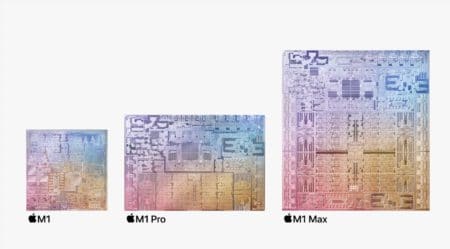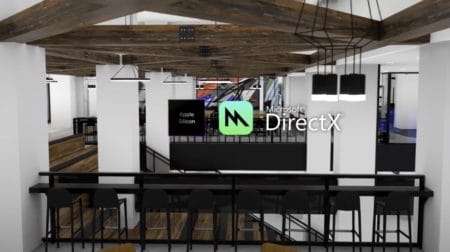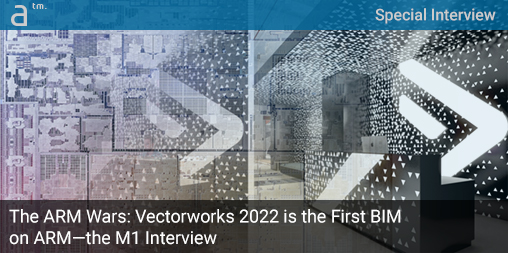Editor’s note: This feature ran first in the October edition of our newsletter INSIDER Xpresso. To gain access to our top content faster and stay ahead of leading-edge technology, please subscribe to our free Xpresso newsletter.
ARCHITOSH HAD THE OPPORTUNITY TO TALK with Steve Johnson, Chief Technology Officer, Vectorworks, a few weeks ago about the new M1-native Vectorworks 2022 product just released.
In this interview, we cover how the M1 SoC is different in many respects, including memory limitations and the complete transition to the Metal graphics API for the Mac version of Vectorworks 2022, which is integral to the big picture M1 story.
Strap in as we talk tech shop about the AEC industry’s first BIM program on the ARM chip architecture.
The Interview
(Anthony Frausto-Robledo) Thanks, Steve, for talking to me so extensively about the M1 or Apple Silicon transition with Vectorworks. Before we dive into that, what is the status of the Apple Metal transition?
(Steve Johnson) — You’re welcome. I’m giddy with excitement, as I just got my personal ARM M1 MacBook yesterday. You know, all of our reengineering over the years is really coming to a head! The M1 system-on-a-chip (SoC) and the unified memory, GPU, and cores are exciting, and Vectorworks 2022 shines on this platform.
The M1 chip maxes out at 16 GB of memory. How does this affect large 3D model performance?
SJ — So the 16 GB is a limit, but we see the paging out to virtual memory, and the engineering that Apple has done with the M1 is superb and makes that limitation almost go away. And, of course, we have the M1X chip coming soon, which will go beyond the 16 GB limit. (note: Apple just announced new M1 Pro and M1 Max chip due in November)
…the paging out to virtual memory and the engineering that Apple has done with the M1 is superb and makes that [memory] limitation almost go away.
It’s a complex story to tell because it is not a straightforward task to compare a system-on-a-chip (SoC) implementation to a separate CPU and GPU. Things work differently between these hardware chip setups.
But you have done lots of testing, right? And what about beta testers and what they are saying?
SJ — Well, getting back to the full Metal implementation, we have been working with beta testers for a while now, and we see good reactions about Vectorworks 2022, which is full Metal on Apple, and the response is that it just feels much faster.
I realize that when we are talking about the full Metal implementation in the new Vectorworks 2022, we are, of course, talking about Metal on both Intel and the new ARM architecture Macs.
SJ — Yes, that’s correct. So, the performance in graphics with Metal can vary depending on the age of the Mac hardware and the specific OS version they are running.
Which macOS is required now as the baseline for version 2022?
SJ — macOS 10.15 Catalina is the oldest Mac operating system this latest version of Vectorworks runs on.
I know we will touch on Metal throughout this conversation about the M1 because the full Metal implementation is a big deal. Still, I want to focus on the M1 because readers and many of your users will be curious about it.
Our single-core bottlenecks have, over time, become multithreaded. Some still exist, and the M1 Mac users will see good speedups. But you are right; single-core processing is impactful with BIM applications.
The M1 chip is a system-on-a-chip (SoC) and wraps CPU, GPU, memory and specialized machine-learning processors, and other specialized cores all together on the same silicon die. It’s precisely like the chip in all of our smartphones, but bigger. But what is unique and perhaps confusing to CAD/BIM users is that its memory is “unified” and shared among CPU, GPU, and the Neural Engine. At just 16 GB total, for these days, that seems like a real limitation for professional CAD industry work.
SJ — When the M1 was out, the first system we got for testing was the MacBook Air M1 with 8 GB of memory. And we ran it with our standard models—and yes, the file sizes were pushing out over that limit—yet you don’t really notice it much.
So Apple’s M1 chip and its motherboard is handling virtual memory that well that you don’t feel it paging out to the SSD drive?
SJ — Yes and no. Recall that back last November, we were doing our testing on Vectorworks 2021. There are a couple of things here and there with specific operations that cause some slow-downs with the paging, but really the transition is just smooth. Things, of course, are even better in 2022, which isn’t using any Rosetta.
Right. So once Apple ships the M1X that goes beyond the 16GB limit, the performance limitations of paging to virtual memory will essentially vanish. What is the largest BIM model you use in tests?
SJ — We have models that push out over the 16 GB limit.

Apple just released new Macs and new Mac chips. The M1 with 16 billion transistors is now surpassed by the M1 Pro with 33 billion transistors and the M1 Max with 57 billion transistors. Architosh has much more info published on these chips. A good place to start is here. (see: Architosh, “Thoughts on Apple’s M1 Pro, Max and the MacBook Pros,” 20 Oct 2021)
Apple’s M1 chip has industry-leading single-core performance at the performance per watt level and nearly absolute level. But what many don’t know is the M1 has stunning floating-point calculation performance as well. That’s going to impact Vectorworks 2022 on M1 well, correct?
SJ — Oh, absolutely. Floating-point comes into play across multiple areas, including the geometry engine and much of the vector-based rendering that architects like so much. So that work is all highly floating-point intensive.
The single-core performance of the M1 is interesting because most CAD software is still so dominantly single-core intensive. For example, the folks at BOXX make this point very clear when they talk about their workstations for Revit or SketchUp.
SJ — Yes, while you can compare applications to applications, we at Vectorworks have a lot of multicore stuff going on. Our single-core bottlenecks have, over time, become multithreaded. Some still exist, and the M1 Mac users will see good speedups. But you are right; single-core processing is impactful with BIM applications.
The CPU speeds are certainly going to be a big hit with our M1 users. That and the work we have done with Metal will wow users with the latest Vectorworks 2022. And the unified memory is just as fast.

The Vectorworks BIM/CAD platform in version 2022 is fully modern in the sense that it is developed for both ARM and Intel X86 Mac and Intel X86 Windows operating systems, with full utilization of low-overhead graphics APIs in Metal and DirectX on Windows.
Now that you are the AEC industry’s first BIM program native on Apple Silicon (or ARM Architecture) and have moved Vectorworks entirely off OpenGL onto bear-metal programming APIs, do you now see opportunities to speed up the application even further?
SJ — Absolutely. We already do that regularly as part of our reengineering efforts with each release. But I understand your question. Now that we are thoroughly modern—meaning we are on DirectX and Metal and off OpenGL and Intel X86 and ARM architectures—we can find areas where we can target performance optimizations, including GPU compute.
Won’t GPU compute be tricky working both across platforms and across chip architectures from Intel to ARM?
SJ — Well, it will be whatever makes the most sense in our cross-platform environment. Some of the texture preparation stuff may make good candidates.
A part of my question about being the first BIM on ARM architecture also gets to the point about Windows and ARM. So, the work you have completed now to get Vectorworks on ARM for Mac will provide you some advantage in getting ready for Windows on ARM once that becomes meaningful, correct?
SJ — Absolutely. There are various ways our work with ARM for Mac helps us down the road for prospects on Windows on ARM. For example, our work in the VGM (Vectorworks Graphics Module) enabled us to switch out OpenGL for Metal for Mac and DirectX for Windows. But that also means we can move to Vulkan if we want to. So that’s the GPU side of it.
But Apple is leading us to ARM, and we are shining there, and that story will turn into a good story for our Windows users at some point down the road.
As for ARM, there will be some challenges, and some algorithms may ultimately need to be tailored for each platform. We shy away from doing those things because we try to focus on cross-platform technologies. But Apple is leading us to ARM, and we are shining there, and that story will turn into a good story for our Windows users at some point down the road.
I know that Parasolid moved over to ARM on Mac rather quickly for their clients, of which you are one. Are further optimizations still out there that center on the geometry kernel for the M1 to take advantage?
SJ — I think there are. When working with Parasolid on our M1 migration work, we faced some challenges related to the Mac threading model. And we worked with them extensively to overcome those challenges. And I think the push to ARM in the industry will ultimately help them more.
For example, when we had to cache the Parasolid geometry calculations rather than do it on the fly, we used more memory in the background, which has its downsides. But as Parasolid gets better with multithreading and their further advancements with their ARM implementation, Vectorworks on the Mac will be a key beneficiary.
These sound like exciting times. Thanks for talking to me about your M1 ARM transition work.
SJ — You are very welcome; it was my pleasure.




Reader Comments
Comments for this story are closed